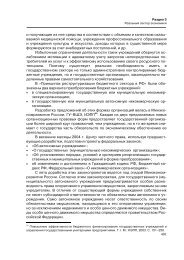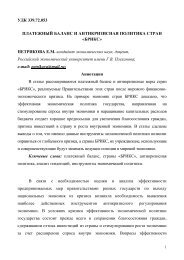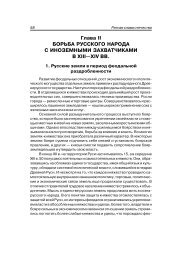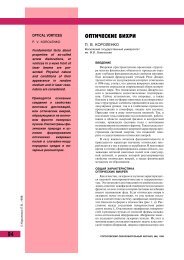Ensuring Strategic Stability in the Past and Present:
Ensuring Strategic Stability in the Past and Present:
Ensuring Strategic Stability in the Past and Present:
You also want an ePaper? Increase the reach of your titles
YUMPU automatically turns print PDFs into web optimized ePapers that Google loves.
52. Such a function could be entrusted to <strong>the</strong> apparatus of <strong>the</strong> Security Council of <strong>the</strong> Russian Federation by <strong>in</strong>clud<strong>in</strong>g <strong>the</strong> relevant department<strong>and</strong> experts <strong>in</strong> <strong>the</strong> organizational structure of <strong>the</strong> Council; such activity was supposed to be carried out by <strong>the</strong> State Military Inspection of <strong>the</strong>Defense Council <strong>and</strong> later by <strong>the</strong> Security Council of <strong>the</strong> Russian Federation.53. Herman Kann, “On Escalation: Metaphors <strong>and</strong> Scenarios,” Baltimore, Maryl<strong>and</strong>: Pengu<strong>in</strong> Books, 1968, p. 39.54. R. H. Betts, “Nuclear Blackmail <strong>and</strong> Nuclear Balance,” Wash<strong>in</strong>gton: The Brook<strong>in</strong>gs Institution, 1987, p. 3.55. S. Hoffman, “The State of War: Essays on <strong>the</strong> Theory <strong>and</strong> Practice of International Politics,” New York: Praeger, 1965, p. 236.56. Analysis of such mistakes should also be <strong>the</strong> subject of special tra<strong>in</strong><strong>in</strong>g courses organized <strong>in</strong> <strong>the</strong> Military Academy of <strong>the</strong> Gen. Staff of <strong>the</strong>Armed Forces of <strong>the</strong> Russian Federation.57. Nuclear sub-kiloton warheads (with a TNT-equivalent nuclear explosive yield of less than 1,000 tons) play a special role; <strong>the</strong>y have recurrentlybecome <strong>the</strong> subject of debates <strong>in</strong> <strong>the</strong> United States over <strong>the</strong> past 15 to 20 years.58. It is well known that <strong>in</strong> <strong>the</strong> Soviet Union, development of such nuclear munitions was demurred by <strong>the</strong> M<strong>in</strong>ister of Atomic Industry of <strong>the</strong>USSR Yefim Slavsky; he believed that this led to a dangerous decrease <strong>in</strong> <strong>the</strong> “nuclear threshold” <strong>and</strong> that <strong>the</strong> responsibility for <strong>the</strong> use of nuclearweapons was entrusted to <strong>the</strong> comm<strong>and</strong> of a very low degree. There were a number of dist<strong>in</strong>guished public figures <strong>in</strong> <strong>the</strong> U.S. who were alsoaga<strong>in</strong>st development of such warfare.59. The U.S. <strong>and</strong> its NATO allies planned to use tactical nuclear weapons at a relatively early stage of a large-scale war <strong>in</strong> Europe aga<strong>in</strong>st a threat oflos<strong>in</strong>g a conventional war with <strong>the</strong> Soviet Union <strong>and</strong> its allies. It was believed that <strong>the</strong> Soviet troops had advantageous configuration, structure <strong>and</strong>composition to defeat <strong>the</strong> NATO task force <strong>in</strong> <strong>the</strong> center, on <strong>the</strong> territory of <strong>the</strong> Federal Republic of Germany. The most perilous location was <strong>the</strong>Fulda Gap. The anticipated activities <strong>in</strong>cluded not just delivery of s<strong>in</strong>gle <strong>and</strong> group nuclear strikes on <strong>the</strong> advanc<strong>in</strong>g Soviet troops, but also <strong>the</strong> useof nuclear m<strong>in</strong>es, which would create absolute obstacles for <strong>the</strong> ma<strong>in</strong> strik<strong>in</strong>g force of <strong>the</strong> USSR: <strong>the</strong> armored forces. Evidently <strong>the</strong> general public(<strong>and</strong> a substantial part of <strong>the</strong> Bundeswehr comm<strong>and</strong>) <strong>in</strong> <strong>the</strong> Federal Republic of Germany <strong>and</strong> Western Europe as a whole were quite hostile tothose plans. This encouraged development of various formulas of “non-offensive defense” with no use of nuclear munitions.60. “Armaments, Disarmament <strong>and</strong> International Security,” SIPRI Yearbook 2007. Translated from English for <strong>the</strong> Russian edition. Edited by A. A.Dynk<strong>in</strong>, A. G. Arbatov, V. G. Baranovsky, A. A. Panayev, A. N. Kaliad<strong>in</strong> <strong>and</strong> A. G. Lisov Moscow: IMEMO RAN, 2008, pp. 560–561.61. See “Yadernoye oruzhie posle ‘kholodnoi vo<strong>in</strong>y’” (“Nuclear Weapons after <strong>the</strong> Cold War”), edited by A. G. Arbatov <strong>and</strong> V. Z. Dvork<strong>in</strong>. Moscow:ROSSPEN, 2006, p. 34.62. In <strong>the</strong> 1970s, when <strong>the</strong> Soviet-American treaties on limitation <strong>and</strong> reduction of nuclear arms were concluded, <strong>the</strong> situation of “mutually assureddestruction” <strong>and</strong> consequently <strong>the</strong> possibility of w<strong>in</strong>n<strong>in</strong>g a war with massive use of nuclear weapons practically was not covered by <strong>the</strong> Sovietpropag<strong>and</strong>a <strong>in</strong>side <strong>the</strong> country.63. “Yadernoye oruzhie posle ‘kholodnoi vo<strong>in</strong>y’” (“Nuclear Weapons after <strong>the</strong> Cold War”), edited by A. G. Arbatov <strong>and</strong> V. Z. Dvork<strong>in</strong>. Moscow:ROSSPEN, 2006, p. 34.64. Reagan’s speech on <strong>the</strong> matter aroused a stormy reaction on <strong>the</strong> part of many Soviet leaders. By that time, Russian-U.S. relations had alreadybeen far from perfect due to, <strong>in</strong>ter alia, <strong>the</strong> br<strong>in</strong>g<strong>in</strong>g of a large cont<strong>in</strong>gent of Soviet troops to Afghanistan <strong>in</strong> 1979. It was almost a hysteria thatengulfed Russia’s political class, start<strong>in</strong>g with <strong>the</strong> Politburo, <strong>and</strong> a major part of <strong>the</strong> Soviet high military comm<strong>and</strong>. Generally speak<strong>in</strong>g, that waswhat <strong>the</strong> Americans had been striv<strong>in</strong>g for: <strong>the</strong>y wanted to make Russia seriously afraid of <strong>the</strong> prospect of implementation of <strong>the</strong> SDI program. Asacademician G. A. Arbatov writes <strong>in</strong> his memoirs, <strong>the</strong>n-U.S. President Ronald Reagan, when evaluat<strong>in</strong>g such reactions on <strong>the</strong> part of Soviet leaders,said that “<strong>the</strong> weapons could not be that bad, if <strong>the</strong> Russians protest aga<strong>in</strong>st <strong>the</strong>m so fiercely.” Arbatov rightly believes that such an eruption ofhysteria on <strong>the</strong> Soviet side simply conv<strong>in</strong>ced Wash<strong>in</strong>gton that “we were afraid of SDI.” G. A. Arbatov, “Chelovek sistemy” (“Man of <strong>the</strong> System”),Moscow: Vagrius, 2002, p. 265.65. L. Freedman, “Deterrence,” Cambridge, UK: Policy Press, 2001, p. 48.66. See, for example, M. Kaku <strong>and</strong> D. Axelrod, “To W<strong>in</strong> a Nuclear War: The Pentagon’s Secret War Plans,” Boston: South End Press, 1987.67. M. Wallop, “Opportunities <strong>and</strong> Imperatives of Ballistic Missile Defense,” <strong>Strategic</strong> Review, fall 1979.68. See V. Shabanov, “Chto stoit za ‘technologicheskim ryvkom’ v kosmos?” (“What is beh<strong>in</strong>d <strong>the</strong> ‘Technological Race’ to Space?”), Izvestia, 27 July1985.69. It should be noted that at <strong>the</strong> turn of <strong>the</strong> 1960s through <strong>the</strong> 1970s, along with <strong>the</strong> development of <strong>the</strong> “classic” missile defense systems, a numberof Soviet scientists <strong>and</strong> experts considered <strong>the</strong> idea of us<strong>in</strong>g non-traditional weapons based on new physical pr<strong>in</strong>ciples: for example, charges<strong>and</strong> charged particles beams for hitt<strong>in</strong>g warheads at <strong>the</strong> term<strong>in</strong>al stage. The scientists had started work <strong>in</strong> that area, which later proved to be a bl<strong>in</strong>dalley, <strong>and</strong> soon after that was scaled down. Empty structures at <strong>the</strong> test<strong>in</strong>g area near lake Balkhash, which later regularly caused stormy discussions<strong>in</strong> <strong>the</strong> United States, became <strong>the</strong> dumb witnesses of those efforts. Around <strong>the</strong> same time, i.e. 10 years before <strong>the</strong> SDI program, <strong>the</strong> conceptsof space-based BMD systems emerged <strong>in</strong> <strong>the</strong> Soviet Union under <strong>the</strong> <strong>in</strong>fluence of achievements <strong>in</strong> space technologies. Such an idea was first putforward by academician Gersh I. Budker, but it was criticized by academicians Lev Artsimovich <strong>and</strong> Boris Konstant<strong>in</strong>ov <strong>and</strong> discarded. Ano<strong>the</strong>rtype of space BMD system (us<strong>in</strong>g <strong>in</strong>terceptor missiles at space combat stations) was put forward by academician Vladimir Chelomei. He made hisBelfer Center for Science <strong>and</strong> International Affairs | Harvard Kennedy School 65
















